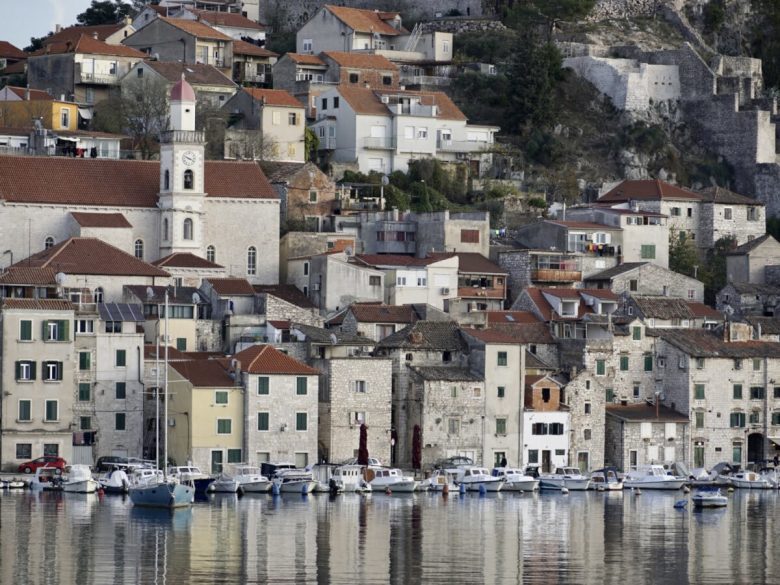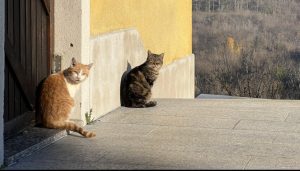In the boomerang shape of Croatia, the southern arm is the region of Dalmatia, tucked between the Adriatic coast and the nation of Bosnia-Herzegovina. Dalmatia also includes most of Croatia’s islands. At the north end of Dalmatia is the city of Zadar where we spent five days (yes, that’s a little more than 101 hours). From Zadar, we also made day trips to visit Croatia’s two most popular national parks, one of which was successful.
We arrived by ferry at noon after a 5-hour trip from Pula which included stops on five different intermediate islands. When we got on the ferry that morning in Pula, less than ten people boarded. When we got off, the number of passengers was around 30 or 40. The ferry could have handled several hundred people and I expect it approaches capacity during the summer months. During our trip, two stretches of open water with a solid swell rocked our high speed catamaran and made for some impressive splashes on our windows as the boat plowed ahead. Fortunately, the ferry was powerful enough that the forward inertia helped maintain a sense of orientation and neither of us got seasick (even if I did I would never admit it). I enjoyed being back at sea for a few hours but will probably always feel uncomfortable as just a rider not DOING anything to operate the ship. You can take the Surface Warfare Officer (SWO) out of the Navy but you can’t take the Navy out of the SWO.
We enjoyed getting a glimpse of the island communities as the boat made its brief stops. We also were interested to see the demographics of who was getting on and who was getting off the ferry. At this time of year, I assume most passengers are Croatians and likely permanent residents of the islands going to the mainland for shopping or to visit family.
Of Croatia’s 700+ islands, fewer than 50 are inhabited and only about 15 of of them have a permanent population over 1,000. Like many rural areas in developed countries, depopulation is a significant issue and the existing island population is aging as young people and young families leave for the urban areas on the mainland. If you care to dive deeper into this issue, I came across a fairly concise medical journal article from 2006 which helps fill in some holes on the historical comings and goings which shaped modern Croatia’s identity.



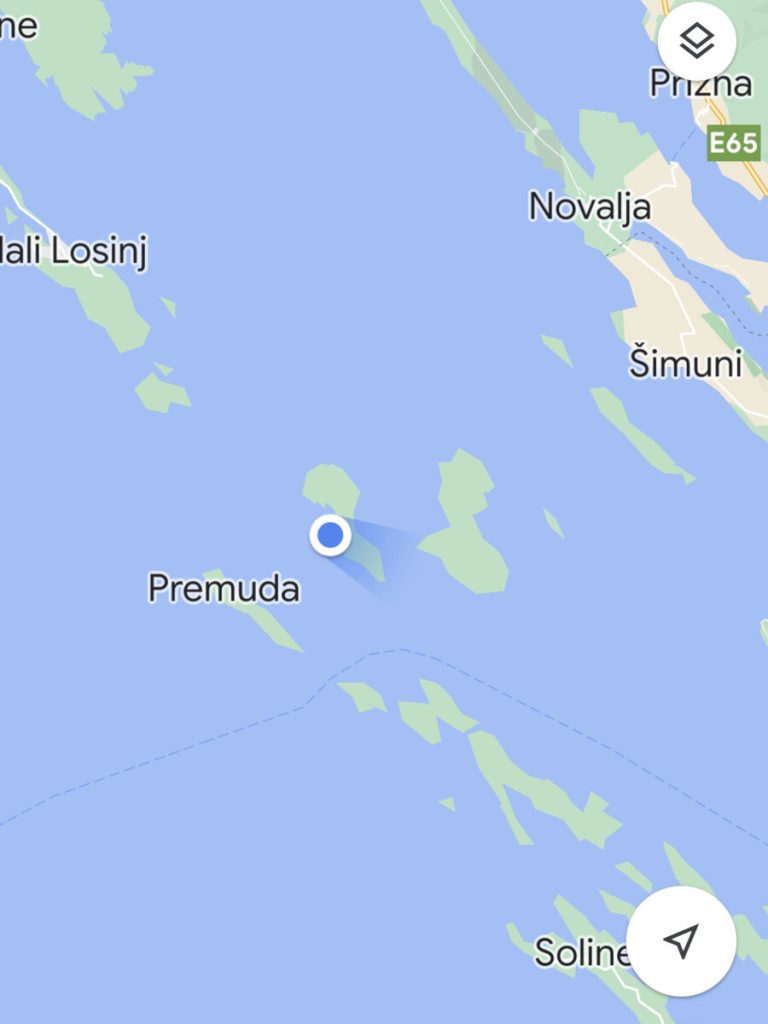

Zadar
Zadar is the second largest city in Dalmatia after Split and the fifth largest city in Croatia with a permanent population of roughly 75,000. Like many cities in this region, Zadar has deep and complex history involving many of the same historical forces as Istrian history but on a slightly different timeline. Thanks to its geography as a low lying city with an excellent natural harbor and a close proximity to trading routes, Zadar’s strategic desirability has also made for some rough historical moments. Among the more notable events in Zadar’s past:
- Zadar is the oldest continuously inhabited Croatian city
- Zadar was the first Catholic city to be attacked by Catholic crusaders in 1202 (an unsavory start to an unsavory 4th Crusade). Like Istria, Zadar was ruled by the Venetians for several hundred years.
- Zadar was the southernmost city on the Adriatic to come under Italian rule after WWI. It remained part of Italy for over 25 years until after WWII, setting the scene for reprisals and counter-reprisals between fascist Italy sympathizers and communist Yugoslav partisans. Surely this struggle had an ethnic component as well but that’s a level of complexity even smart people can’t explain.
- Zadar was bombed extensively by the Allied air forces in 1944 during WWII, which destroyed 80% of its buildings and made Zadar the “Dresden of the Adriatic”. Like all strategic bombing campaigns, the civilian death toll estimates vary dramatically and are a hot potato if you say a number.
- Like other cities on the Dalmatian coast, Zadar experienced a massive exodus of ethnic Italians following WWII. Zadar clearly bears the imprints of Italian influence today and I expect many wounds are still healing from the advance and retreat of successive empires.
Notwithstanding this occasionally tumultuous history, Zadar today is a beautiful city with a sprawling urban zone and a small historic center on a peninsula that has retained its historical charm despite the extensive damage from the bombing raids of WWII. Zadar has a large harbor and is a hub for the hundreds of sailboats, yachts, and ferries that cruise the Adriatic.
As we walked the historic area, we saw the full spectrum of its history from Roman columns to centuries old to carvings of the Venetian St Mark’s lion to city walls to post-war construction. We stayed in an apartment within the historic center just a block from the outdoor market and the bridge connecting the old town to Zadar’s main commercial hub across the narrow harbor.





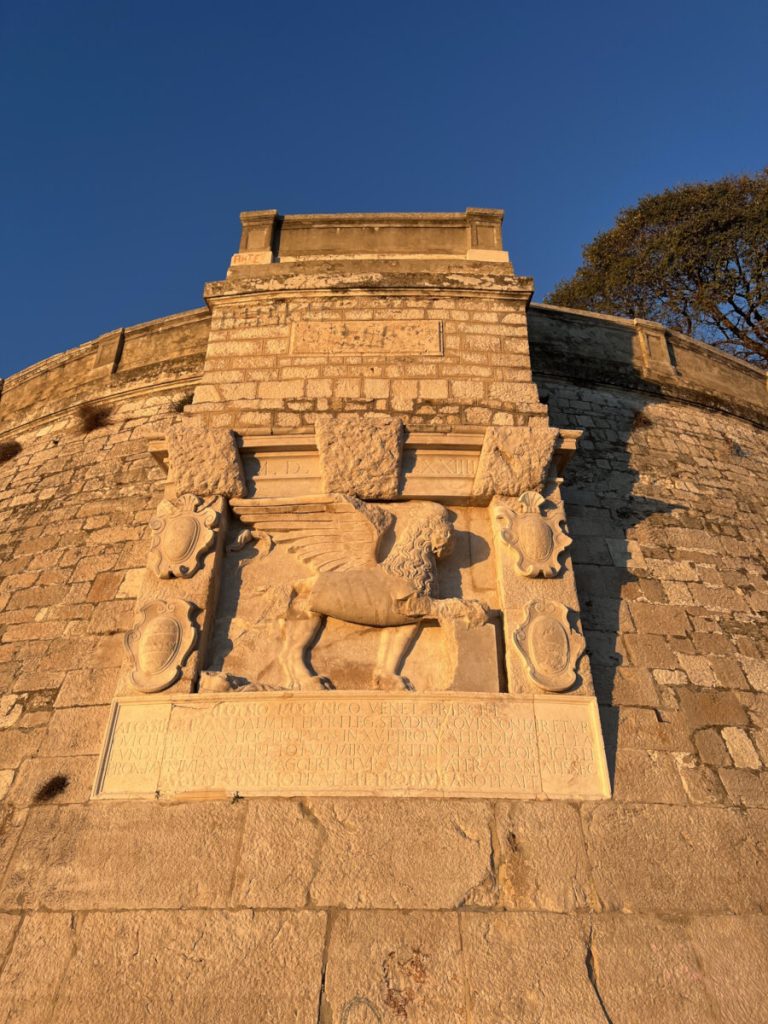


One modern attraction in Zadar is its famous Morske Orgulje (“sea organ”) which won architectural prizes for its creativity and ingenuity. Located on the boardwalk facing the Adriatic, the sea organ is a section of the boardwalk beneath which a series of “organ pipes” play notes as the wave action of the sea moves water in and out. Even in calm conditions, the gentle swell is enough for the organ to produce music. Hearing it play is such an interesting experience, I don’t know why this idea hasn’t been mimicked in seaside tourist destinations around the world. For a great explanation of the sea organ and some nice overhead imagery of Zadar, here’s one of many great videos available on YouTube. Photographs don’t do the organ justice but it’s nonetheless a beautiful setting. Nearby is a big circle of solar panels and LED lights that visually entertains visitors after dark in the same way the sea organ entertains listeners 24/7.



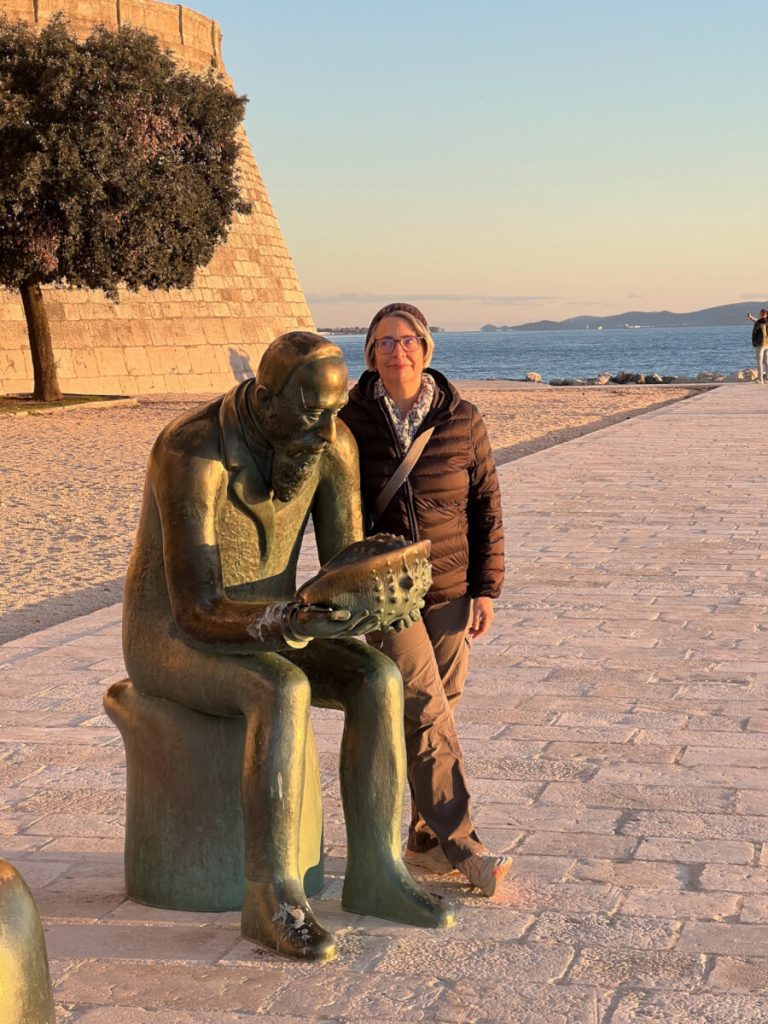


We took a walk across the bridge into the modern part of Zadar (modern means <200 years old in this part of the world). Among other interesting sites, we found a sphinx built by a wealthy citizen to commemorate the death of this wife. The statue has become something of an icon for Zadar.






Croatia takes their Advent celebrations seriously. Just like we saw in Opatjia and Pula, the town square was rigged for holiday festivities.
Qatar’s historic hosting of the World Cup in Nov-Dec added an unprecedented element of excitement to the Advent celebration as local residents watched their national team excel on the big screen during World Cup Group stage games. We saw Croatia’s 4-1 defeat of Canada on our first night and their 0-0 tie with Belgium on our last night. The Croatian national spirit combined with the Christmas spirit is a powerful concoction. The Kuhano Vino (mulled wine) helps, too.



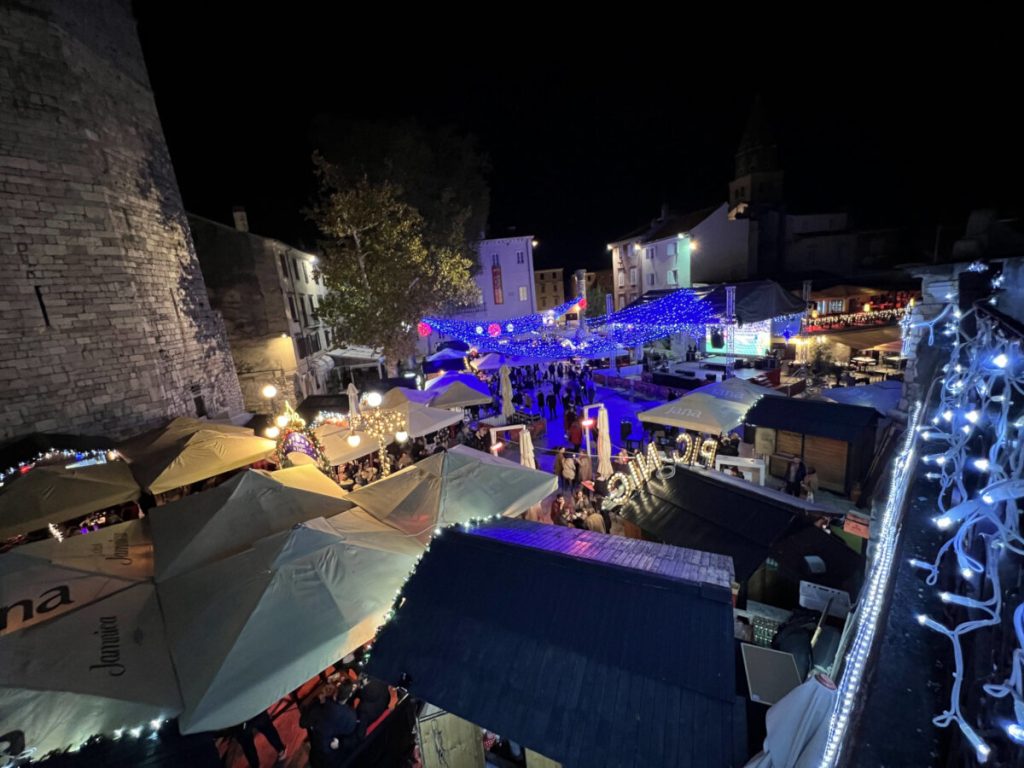
After its beaches and islands, Croatia’s most famous attraction is the Plitvice Lake (pronounced something like Plee-VEET-sa) which is 70 miles northeast of Zadar over the coastal mountain range. We really wanted to see this natural wonder so we rented a car for two days and added to our itinerary the less well-known Krka National Park located only 50 miles down the coast from Zadar (and slightly inland). I thought the weather forecast showed good weather for both parks but I was making that judgment based on Zadar’s weather forecast. What I failed to appreciate was the dramatic climatic change that happens when you pass through a 3-mile tunnel from one side of the mountain range to the other. As we later learned from the locals, that tunnel just connect the two sides of the mountain. It connects two completely different weather systems.
Krka National Park and Sibenik
We visited Krka first and had a gorgeous weather the entire day, including a visit to the city of Sibenik (pronounced Shee-BEN-eek). Krka is quite large and requires 2-3 days to do the park full justice. In typical tourist style, we went with “what can we see in a few hours?” and focused our visit on the headliner waterfalls, which we accessed by parking at the Lozovac entrance and walking a short distance down the hill. In the off season, we could have driven all the way down and parked at the bottom but this offended our sense of adventure. This site is more than just waterfalls. It’s an entire ecosystem of wetlands as the crystal water takes thousands of paths in search of lower elevation. We immediately could see the water was higher than normal which added to the enjoyment of walking the elevated pathways and seeing the water tumbling along. The path takes at least an hour to complete so it’s a much more robust experience than just taking a selfie in front of the waterfall.
Interesting waterfalls are no match for interesting people. During our visit to Krka, we met an American family with three teenage kids. The dad was a doctor in the U.S. and took a break so their family could travel the world. They sold their house and most of their possessions and hit the road in a camper traveling around the U.S. and Mexico. Then, they flew to Europe, leased a car in France, and have been moving about Europe for the past year. We talked to them for nearly an hour and enjoyed hearing about their experiences, their challenges with homeschooling and college applications (for their oldest child), and their upcoming plans to visit southeast southeast Asia and New Zealand. They live on a budget of roughly $5000/month. If anyone thinks our four month trip amid the relative security and comfort of Western Europe is adventurous, I would say it’s JV compared to the hard core world travelers out there. Besides, I have a lot of experience traveling with teenagers and let me tell you it makes even the hardest moments of traveling as a couple feel pretty dang easy. This family definitely inspired us. We traded contact information and figured out we are likely to overlap in Zagreb in mid-December just before we return to Spain for the holidays.








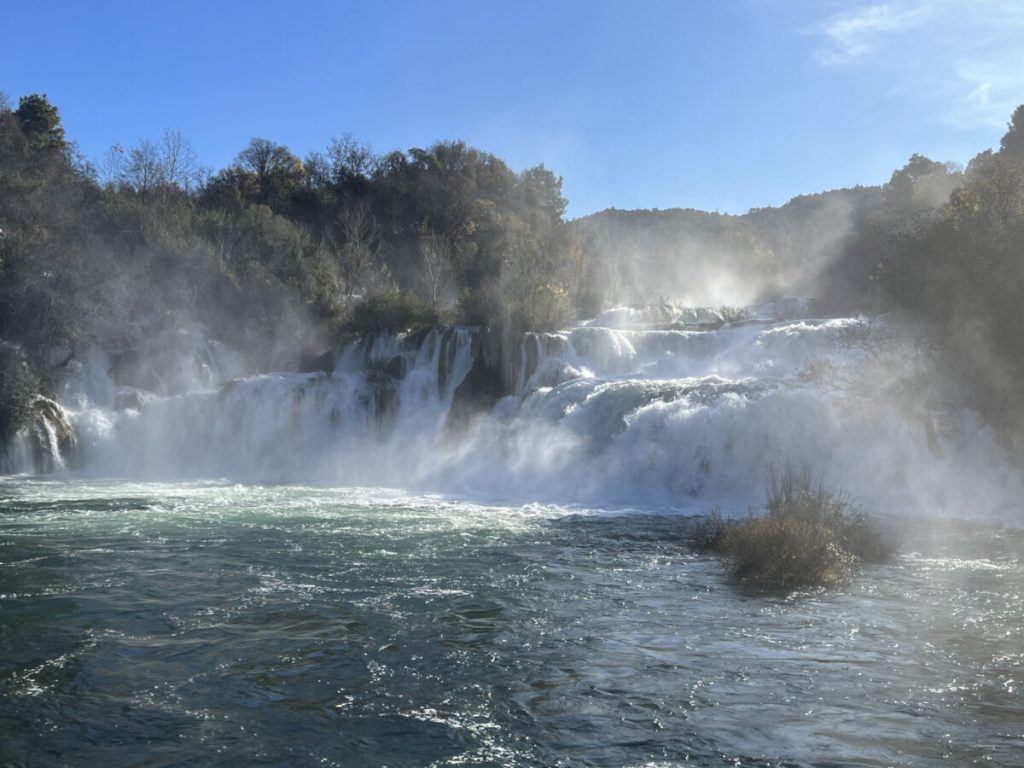

Between talking to our fellow American travelers for an hour and not anticipating the tourist area’s restaurants would ALL be closed for the season, we found ourselves hungry and not not knowing where we’d find our next meal. In an alternate history where we packed a lunch, we would have gone deeper ito the park to the overlook of the 15th century Franciscan monastery in the middle of Vivosac lake and the other popular waterfall called Roski Slap. But we were hungry so we opted instead to head south and find lunch in the city of Sibenik.
Like Zadar, Sibenik sits on the water but the water is a large lake formed by the river finding its way to the Adriatic. A canal across the water connects the lake to the sea.
Also like Zadar, Sibenik was bombed by Allied air forces during WWII, which the city advertises repeatedly in their website information and tourist information signs that the historic and architecturally significant City Hall was destroyed in the bombing campaign. You kind of get the sense they are still a bit pissed about having to re-build their City Hall, which was done based on the original 16th century Renaissance design (but probably with better A/C). They weren’t happy about the Nazis being there in the first place so it’s hard to blame them for holding a grudge. We read bout the WWII bombing several times but here’s one example.
During Croatia’s war of independence with the former Yugoslavia , the level of armed conflict was somewhat proportional to the number of ethnic Serb and the Yugoslav army occupied the region along what is today the Croatian border with Bosni-Herzegoviena. Due to its geography as Dalmatia gets skinny, Sibenik became a hot spot of the war resulting in the Battle of Sibenik in September of 1991. Although military and civilian casualties were relatively light (emphasis on relatively), the battle included shelling of the city with the ostensible purpose of psychological warfare. The shelling also targeted the historic area and damaged the Cathedral of St. James, which is a UNESCO world heritage site and among the most architecturally unique churches in Croatia. For any Game of Thrones fans out there (I am not one of them), this cathedral was the backdrop for the “Iron Bank” in season 5, episode 9. More broadly Sibenik portrayed Braavos, the city where the Iron Bank is located







Foodie footnote. We had lunch at a waterfront restaurant which offered that perfect balance of being mostly full with apparent locals (tourists are just not much of a thing this time of year) but also with some good tables available. The menu was typical Croatian food and our orders were typical Lyn and Brian orders. Can you guess who ordered what in the photos below?
We also learned from our waiter that Sibonek is the hometown of an NBA player. We didn’t fully follow who it was but later figured out that SIbenik has produced several NBA players including Drazen Petrovic of the New Jersey Nets (his career was cut short by a fatal car accident in 1993) and current Phoenix Suns player Dario Saric . The waiter was a bit of a name dropper and also made a point of telling us Jeff Bezos and other American millionaires had visited Sibenik in more recent times. Of course, they all arrived on super-yachts while touring the Adriatic coast and not in Economy-class rental cars.


Near our parking spot in Sibenik, we came across the Croatian Navy re-fueling an amphibious landing craft at a commercial pier. We were focused on finding lunch, so I regret not engaging the Croatian Navy guy sitting nearby waiting for the tank to get filled. While we were eating lunch, the LCU got underway and chugged off, so I missed my chance for getting some context on how that craft is used by the Croatian Navy, but it warmed my Gator Sailor heart nonetheless just to see it.

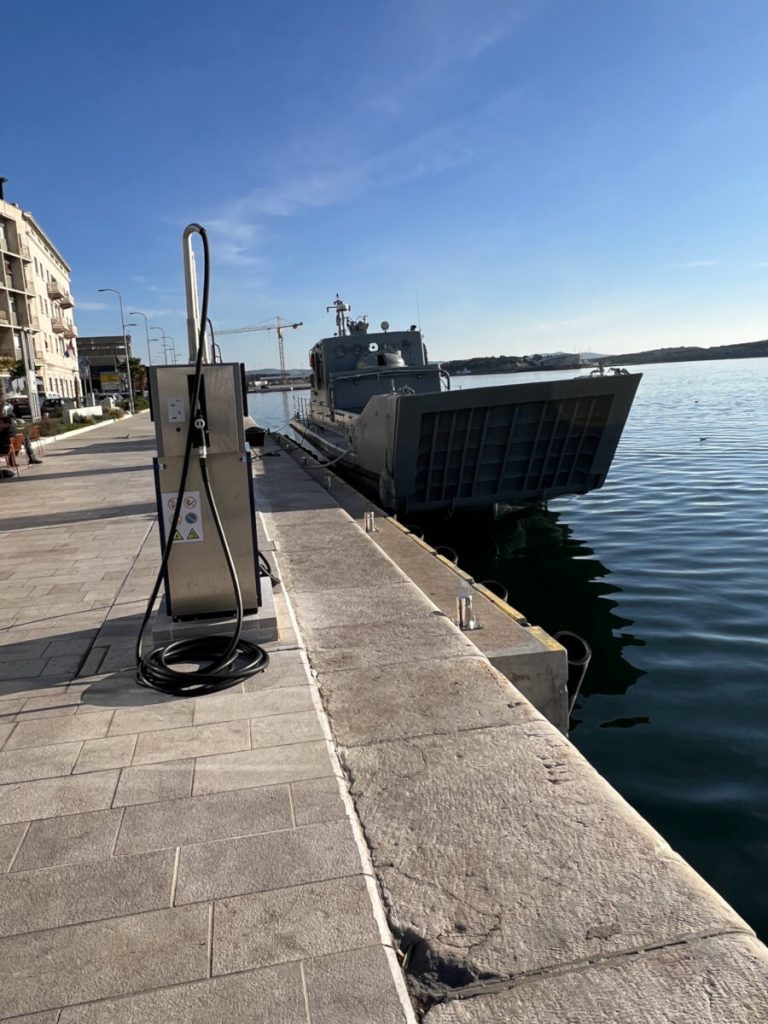
Plitvice Lakes
Plitvice means “shallow” in Croatian but based on our experience it might as well mean “shrouded”. To appreciate our misadventure fully, I recommend pausing here and watching the two-minute Rick Steves’ video about Plitvice Lakes National Park at this YouTube link. He lays it on a bit thick but you will definitely come away with great expectations of your visit there.
I mentioned the tunnel connecting the two sides of the coastal mountain range. We went in one side with partly cloudy skies and an outside temperature of 53F (12C) and when we came out the other side we were INSIDE the cloud and the temperature had dropped to 39F (4C) and we hadn’t even changed elevation.
I rationalized that the weather would improve as we came down the mountain and approached the lakes but it was exactly the opposite. The closer we got the worse the visibility. The temperature got a little warmer as we descended the mountain but then it dropped again as we approached the lakes.
We had booked a nice hotel inside the park called the Ethno Houses Hotel which is something like staying at the lodge inside one of the U.S. national parks. Having confidence in our rental car and the weather forecast, I had saved a few bucks by making the reservation non-refundable (the risk calculus seemed entirely rational at the time).
Here’s what I didn’t know. The road into the hotel was a narrow (1.5 lane) dirt road for about two miles and it hugged a ridge overlooking a valley. In good conditions, this road was entirely manageable but the weather forecast was calling for snow the next morning and we could only envision having to drive out up hill on a snow covered unmarked road with a dropoff to one side.
When we got to the hotel reception, we learned a few mor things. First, we were the ONLY guests with a room reserved; second, the boat for getting to the main sites in the park was not running; third, the restaurant attached to the (remotely located) hotel was closed. The young man at the reception desk could not have been nicer to us and even offered to make a case to his management about refunding our room (management ultimately didn’t see it that way; a deal’s a deal). After some discussion, and considering the forecasted snow, I swallowed by cheapskate pride we decided to leave ahead of the snowfall and drive two hours back to Zadar after seeing what we could without the boat ride. This left us with only one final challenge…could we actually see the lake?
I’m not old enough to have first hand experience with cataracts but our visit to Plitvice Lakes gave me a good idea of what it must be like. The calcium carbonate in the water apparently makes the water exceptionally clear. As you will see in photo #5 below, I think the underwater visibility for a diver was oddly greater than the above water visibility for a hiker. The waterfalls were similar to what we had seen the previous day at Krka national park so we at least could envision how beautiful it must be with the sunny weather and blue sky like Rick Steves had.
We hiked for about two miles and encountered three other visitors during that time, which gave me comfort for not being the only idiot in Croatia. Based on what we read online, Plitvice is bursting with tourists in the summer. We didn’t see much of the lake but we certainly found some serenity.
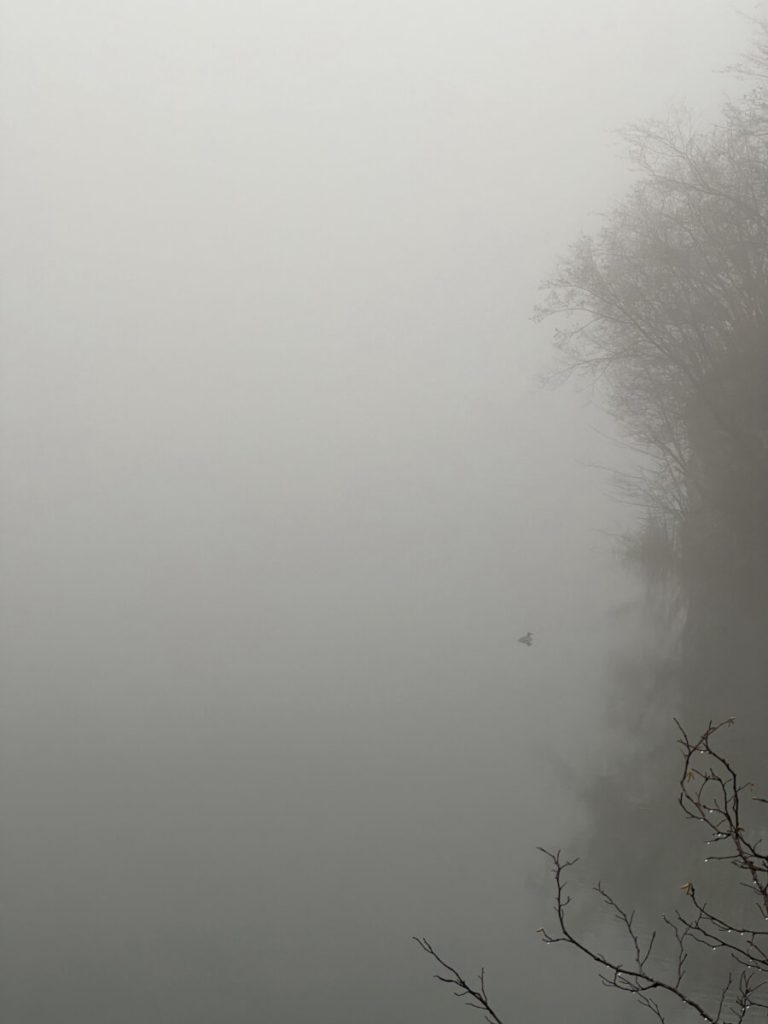

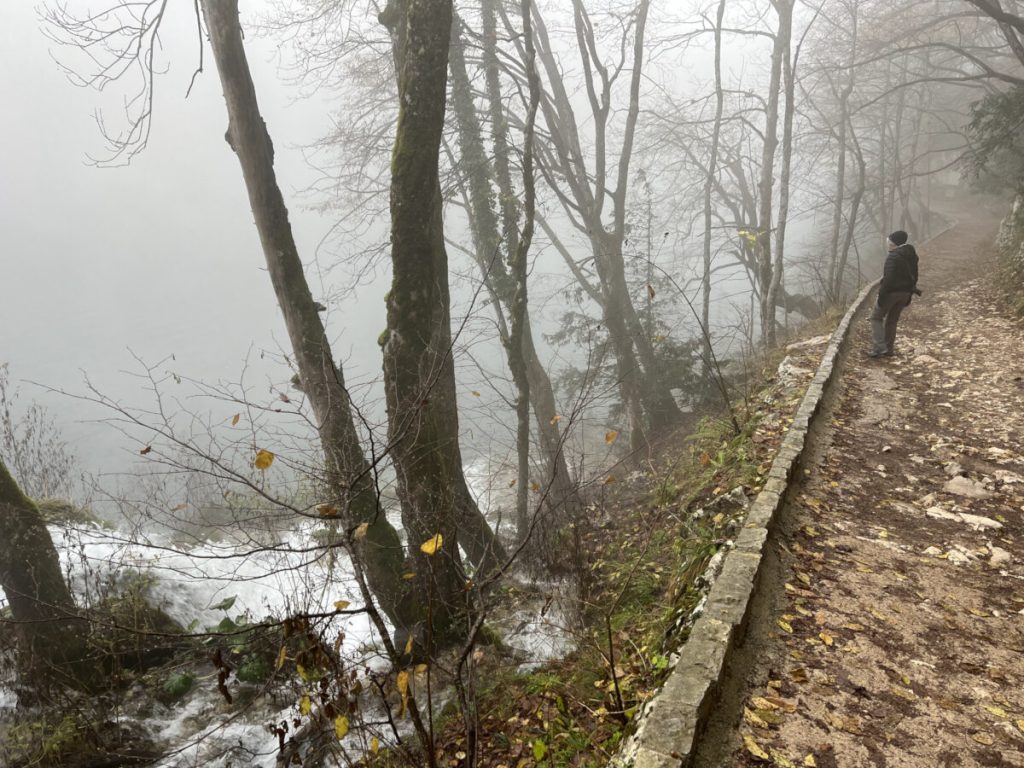




Pag Island
With the spare time we had from our abbreviated visit to Plitvice Lakes, we decided to swing wide and visit Pag Island on the drive back to Zadar. Pag is famous for its sheep cheese, its sea salt production, its arid climate, and its party culture for summer tourists. Our Hertz friend in Pula had told us Pag looks like the moon because it’s so dry. I’m not sure how she knew that because I’m certain the Croatians have never sent anyone to the moon. We drove about half of the island’s length to convince ourselves we were missing anything on this cold, windswept island. The whole day was a bit of a wild goose chase, but that’s how travel goes sometimes.




Put Zadar on your Radar
We didn’t know what to expect, but we sure were pleased with our visit to Zadar. Like Pula, we probably would have been just as happy trading one of our two road trip days (especially Plitvice) for hanging around the city and soaking up some more of its atmosphere. We did not visit any of the churches or museums, partly because they were either closed or operating at reduced hours for the off season. We did love Krka national park and Sibenik so that trip was well worth it and Plitvice would have probably lived up to the Rick Steves hype had we visited in August or September.
Like Pula, Zadar is enough of a city to have vibrant urban heartbeat even in the low season. And its amazing sea organ plays 24/7/365.
We intentionally made our visit to Zadar a bit short because we wanted to have two weeks in one place to slow down our place before the holidays and focus on absorbing the nuances of the local character. We chose Split for that destination, just an easy two hour bus ride south. Farewell, Zadar.
